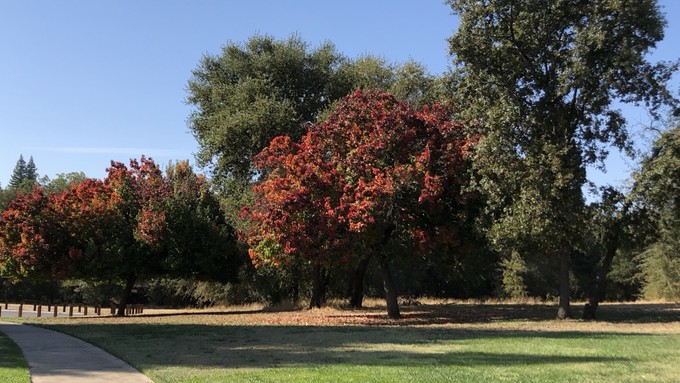
Thanks to wet winter, Sacramento's annual rain total for 2023-24 almost average

It's fall, it's October, and trees are just starting to show their seasonal colors. It's also the start of a new Water Year. Kathy Morrison
It’s official; it’s hot. But it’s also been pretty dry.
Sacramento started a new “Water Year” Oct. 1 with a 100-degree-plus day – and another likely today (Wednesday). According to the National Weather Service, Tuesday’s 101 was the 46th triple-digit day in Sacramento since June 1.
This week’s high temperatures are running about 20 degrees above normal for early October. With temperatures up to 106 degrees, a heat advisory remains in effect in the Sacramento Valley through 11 p.m. Thursday.
This current hot spell also has been very dry, toasting vegetation and creating high fire danger.
In fact, Sacramento has seen precious little rain since May with only a trace in September. Average for those summer months usually isn’t much, but it’s something: 0.36 inches.
And that was just about the difference between a totally average Water Year and one slightly below that mark.
Used by climatologists to evaluate water resources, our Water Year runs from Oct. 1 to Sept. 30. Average for downtown Sacramento: 18.14 inches.
Concluded on Monday, our 2023-24 Water Year totaled 17.6 inches. That sum was buoyed by a wet winter; big storms in December, January and February added up to 12.85 inches, more than 2 inches above normal for that period.
That wet winter brought a flurry of spring growth in wildlands. But our crispy summer – the hottest on record – parched that vegetation, increasing our fire danger.
Last fall, our Water Year got off to a slow start with only 0.96 inches total for October and November – 1.5 inches below average. But a very damp December (4.69 inches) made up for that deficit and kept us out of drought.
How will this Water Year shape up? Stay tuned; it’s too early to tell.
Meanwhile, keep some water handy and stay hydrated during this heat spell. (That goes for your garden, too.) A return to more normal fall temperatures is expected next week.
For more on Sacramento weather: https://www.weather.gov/sto/#
Comments
0 comments have been posted.Sacramento Digs Gardening to your inbox.
Food in My Back Yard Series
May 6: Maintain soil moisture with mulch for garden success
April 29: What's (already) wrong with my tomato plants?
April 22: Should you stock up on fertilizer? (Yes!)
April 15: Grow culinary herbs in containers
April 8: When to plant summer vegetables
April 1: Don't be fooled by these garden myths
March 25: Fertilizer tips: How to 'feed' your vegetables for healthy growth
March 18: Time to give vegetable seedlings some more space
March 11: Ways to win the fight against weeds
March 4: Potatoes from the garden
Feb. 25: Plant a fruit tree now -- for later
Feb. 18: How to squeeze more food into less space
Feb. 11: When to plant? Consider staggering your transplants
Feb. 4: Starting in seed starting
Sites We Like
Garden Checklist for week of May 11
Make the most of the lower temperatures early in the week. We’ll be back in the 80s by Thursday.
* Plant, plant, plant! It’s prime planting season in the Sacramento area. Time to set out those tomato transplants along with peppers and eggplants. Pinch off any flowers on new transplants to make them concentrate on establishing roots instead of setting premature fruit.
* Direct-seed melons, cucumbers, summer squash, corn, radishes, pumpkins and annual herbs such as basil.
* Harvest cabbage, lettuce, peas and green onions.
* In the flower garden, direct-seed sunflowers, cosmos, salvia, zinnias, marigolds, celosia and asters. (You also can transplant seedlings for many of the same flowers.)
* Plant dahlia tubers.
* Transplant petunias, marigolds and perennial flowers such as astilbe, columbine, coneflowers, coreopsis, dahlias, rudbeckia and verbena.
* Keep an eye out for slugs, snails, earwigs and aphids that want to dine on tender new growth.
* Feed summer bloomers with a balanced fertilizer.
* For continued bloom, cut off spent flowers on roses as well as other flowering plants.
* Add mulch to the garden to maintain moisture. Mulch also cuts down on weeds. But don’t let it mound around the stems or trunks of trees or shrubs. Leave about a 6-inch-to-1-foot circle to avoid crown rot or other problems.
* Remember to weed! Pull those nasties before they set seed.
* Water early in the day and keep seedlings evenly moist.